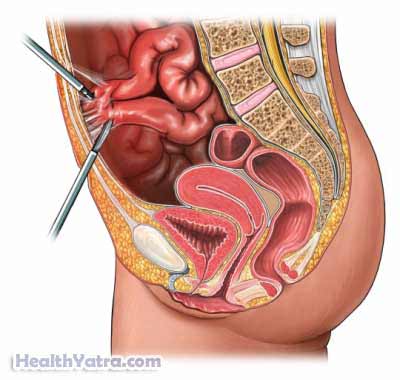Definition
Adhesions are scars that form within the body. They usually form in the abdomen or pelvis. Adhesions develop naturally after surgery as part of the healing process. They can also develop after infection or any other inflammatory process, such as:
- Endometriosis
- Diverticulitis
- Appendicitis
Lysis of adhesions is the process of cutting scar tissue within the body. This is done to restore normal function and reduce pain.

Reasons for Procedure
Adhesions can cause:
- Pain
- Obstruction of the bowel
- Infertility
This surgery can fix intestinal blockage and treat infertility caused by adhesions. It also reduces chronic abdominal pain in some individuals.
Possible Complications
Complications are rare, but no procedure is completely free of risk. If you are planning to have lysis of adhesions, your doctor will review a list of possible complications, which may include:
- Injury to organs
- Worse adhesions
- Bleeding
- Infection
Factors that may increase the risk of complications include:
- Pre-existing heart or lung condition
- Obesity
- Major abdominal surgery in the past
- Smoking
- Diabetes
Be sure to discuss these risks with your doctor before the surgery.
What to Expect
Prior to Procedure
Your doctor will perform a physical exam and may order some of these tests:
- Blood and urine tests
- Ultrasound —a test that uses sound waves to visualize the inside of the body
- CT scan —a type of x-ray that uses a computer to make pictures of the inside of the body
- MRI scan —a test that uses magnetic waves to make pictures of the inside of the body
Leading up to the surgery:
- Talk to your doctor about your medicines. You may be asked to stop taking some medicines up to one week before the procedure, like:
- Anti-inflammatory drugs (eg, aspirin )
- Blood thinners, such as clopidogrel (Plavix) or warfarin (Coumadin)
- Arrange for a ride home from the hospital. Also, arrange for someone to help you at home.
- Eat a light meal the night before the surgery. Do not eat or drink anything after midnight.
Anesthesia
General anesthesia —blocks pain and keeps you asleep through the surgery; given through an IV in your hand or arm
Description of the Procedure
This surgery is usually done laparoscopically. After you are asleep and not feeling any pain, a needle will be inserted to inject a gas into the abdomen. The gas will make the abdomen expand. This will make it easier to see the organs. The laparoscope will then be inserted through a small hole that is cut in the skin. The laparoscope lights, magnifies, and projects an image onto a screen. The area will be inspected. The doctor will make several small incisions in the wall of the abdomen. Using small instruments that are put through these holes, the doctor will cut out the adhesions. Doing so will free the organs that were caught in the adhesions.
In some cases, the doctor may need to switch to open abdominal surgery (calledlaparotomy). The doctor will make a larger incision in the abdomen. This will allow direct access to all of the organs. The adhesions will be cut out.
How Long Will It Take?
1-3 hours
How Much Will It Hurt?
You will have soreness for a few days during recovery. If you needed open surgery, you will have more pain. The doctor will give you pain medicine.
Average Hospital Stay
This surgery is done in a hospital setting. If you have laparoscopic surgery, you will be able to leave that day or the next. If you have open surgery, you will need to stay in the hospital for a few days. You may need to stay longer if you have complications.
Post-procedure Care
When you return home after the surgery, do the following to help ensure a smooth recovery:
- Be sure to follow your doctor’s instructions .
- Keep the incision area clean and dry.
- Ask your doctor about when it is safe to shower, bathe, or soak in water.
- Take pain medicines as directed by your doctor.
- Avoid heavy lifting.
- Do not drink carbonated beverages for two days.
Call Your Doctor
After you leave the hospital, contact your doctor if any of the following occurs:
- Signs of infection, including fever and chills
- Redness, swelling, increasing pain, excessive bleeding, or discharge from the incision site
- Pain that you cannot control with the medicines you have been given
- Nausea and/or vomiting that you cannot control with the medicines you were given after surgery, or which persist for more than two days after discharge from the hospital
- Diarrhea, constipation, bloody stool, or black stool
- Abdominal swelling
- Trouble urinating
- Cough, shortness of breath, or chest pain
In case of an emergency, call for medical help right away.
